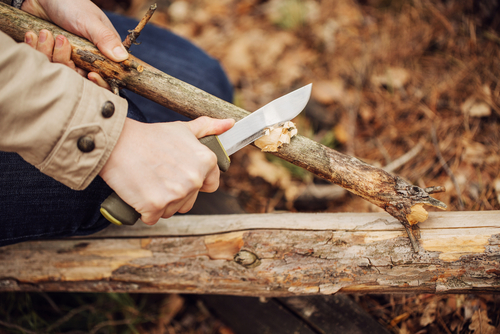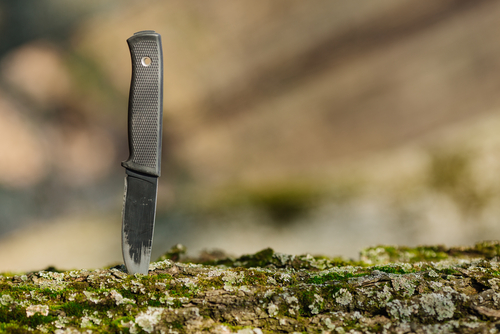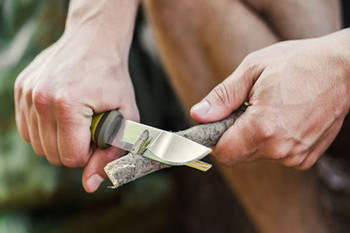Custom Fixed Blade Knives: A Wilderness Survival Essential
Jun 19th 2018

When it comes to survival necessities, whether you are looking to outfit your next camping or hunting trip or are a prepper, few things should rank as high on your essentials list as a custom fixed blade knife.
Though they may not be designed for convenient everyday carry, custom fixed blade knives are your best bet in survival situations. They are the perfect tools for tackling the bigger cutting, chopping, thrusting and prying tasks that a folding knife simply can’t handle.
Before you add just any knife to your bug-out bag, check out these tips and tricks for picking the perfect custom fixed blade survival knife for your wilderness survival needs.
Why Use a Fixed Blade?
While folding knives will undoubtedly serve you well in everyday carry situations, thanks to their concealability and ease of use, there are quite a few advantages to fixed blade knife models that make them the better choice for wilderness survival situations.
- No Pivot or Joint Weakness
The very defining feature of a folding knife—the pivot mechanism that allows the blade to be stored in the handle—is also its biggest weakness, especially in survival situations. That is, just like the joint of the body, the hinge of a folding knife is a major component of its proper functioning as well as a tremendous weak point in its design.
A survival knife needs to handle heavy-duty, high-impact jobs that the joint of a folding knife is not designed for.
- Full Tang
The term tang refers to the extent to which the blade continuously extends into the length of the handle, and it is a vital point of determining a knife’s strength and durability.
Knives are either full tang, with the blade extending from the tip to the entire length of the handle, or partial tang, where the blade continues only partially into the handle if at all.
Folding knives are partial tang, which is too flimsy to stand up to all of the jobs you need your survival knife to handle, and they can develop looseness or “play” more readily then full tang fixed blades.
- Easier to Maintain
Another huge weakness of the folding knife and its use in survival situations is its higher maintenance needs. A folding knife’s function largely depends on the folding and spring mechanisms that open and close the blade.
This mechanism requires continual maintenance, as it is easily clogged, hindered or rendered altogether useless by dirt and corrosion, two all-too-common occurrences in survival situations.
The simple design of a fixed blade, on the other hand, is better in this case and allows for consistent, reliable tactical use that is always at the ready.
Different Uses for a Fixed Blade

Though there are various obvious uses for your survival knife, there are likely quite a few potential uses you never considered for your custom survival knives, including:
- Cutting, slicing and piercing with the blade
- Whittling other tools
- Prying things open
- Dressing, filleting and skinning game
- Splitting and batoning wood
- Digging
- Sterilizing and cauterizing by heating the blade and applying it to wounds
Things to Keep in Mind

Now that you know the why behind choosing a custom fixed blade survival knife, there are a few things to consider when choosing the right option for you.
- Grip
There are innumerable options when it comes to fixed blade knife grips that run the gamut from rustic to cutting edge.
Some of the most popular for survival knife grips are micarta, glass reinforces nylon, Zytel and G-10 materials, as they all offer high function, low maintenance and reliable durability.
However, grip typically comes down to preference, and it is best to try out any material and gauge how it feels in your hand rather than taking someone else’s word for it.
- Length and Weight
While there is no universal perfect weight and length for a survival knife, there is a perfect size and weight for you.
It all comes down to your physical characteristics and what you need your knife to do. Long knives take up more room and are heavier, but they also afford better chopping, prying and hacking abilities to their user.
That being said, a heavier knife can cause fatigue, and there is no use in having a big knife in your bag if you can’t use it for long periods.
- Blade Options
Some of the more common blade options for survival knives include drop point, serrated, gut hook, tanto, chisel tip and clip point, each with its list of pros and cons and intended uses.
For example, a serrated blade typically stays sharp longer and is perfect for cutting meat and ropes. However, a serrated blade won’t do you much good when it comes to prying and chopping.
Choose the blade that will fulfill the most critical roles for your survival needs.
The Takeaway
When finding the right custom survival knife for you, take these basics into account. Along with your personal preferences and intended use, knowing what to look for and how to use the various features of a fixed blade knife are the best tools you can utilize to find the perfect survival knife.

